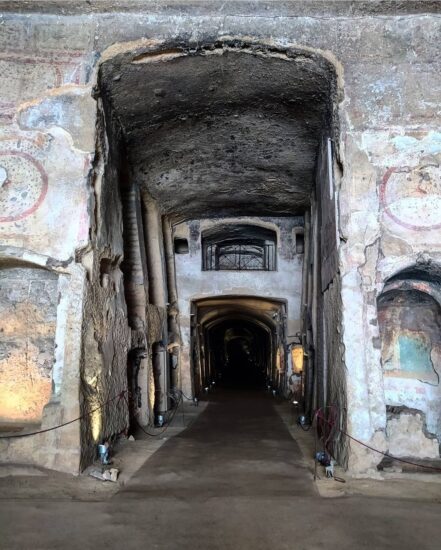Catacombs of San Gennaro
The Catacombs of San Gennaro Naples is a prime example of the wealth of cities with different “layers” of history. The Greek Neapolis and the present-day city are not separated by millennia but by a few meters of soil under the ground like in the case of the Catacombs of San Gennaro.
The past is not placed in a glass case or forgotten, but peeps out in some parts of the present-day city. This coexistence of eras has acquired increasing value in the city’s economy, through the integration of archaeological finds in contemporary public works, such as the Municipio station on Metro Line 1.


In Naples, under the ground is primarily where you bury your loved ones and encounter their souls. Just as the remains are exposed in the city, their souls are also inhabitants in all respects, because the relationship with the afterlife is part of everyday life. Dialogue with the dead has always accompanied the life of the city, through idioms, devotions, and ancient rituals.
Likewise, the saints are always present in the daily life of Neapolitans, whether in intercessions for important graces or minor requests. Small sacred images are still faithfully kept in wallets, while the votive aediculae scattered among the alleys are like little altars.
The Catacombs of San Gennaro are arranged on two levels that are not superimposed, both characterized by much larger spaces than the more famous Roman catacombs. This is due to the workability and strength of the tuff.


The original nucleus of the Catacombs of San Gennaro dates back to the 2nd century AD. It was probably the tomb of a noble family, who then provided spaces for the Christian community. The expansion began in the 4th century AD following the deposition of the remains of St. Agrippinus, the first patron of Naples, to the underground basilica dedicated to him.
The underground basilica consists of a single nave dug out of the tuff, which still preserves a bishop’s chair carved into the rock, and the altar with an opening. In the nave the faithful could see and touch the saint’s tomb. The lower catacomb extends around the Basilica of Sant’Agrippino, following a reticulated structure. The vast spaces and the regularity of their shapes silently welcome visitors into a timeless place.



The imposing lower vestibule, with ceilings measuring up to 6 meters high, houses a large baptismal font commissioned by Bishop Paul II, who took refuge in the Catacombs of San Gennaro in the eighth century during iconoclastic struggles. The artistic heritage of the Catacombs ranges from pre-existing pagan items from the 2nd century AD to Byzantine paintings of the 9th-10th century AD.
One of the most striking areas is the vestibule of the upper catacomb, which was decorated at the beginning of the 3rd century in the so-called Pompeiian style and conserves the earliest Christian paintings in southern Italy. Perhaps the most precious place is the Crypt of the Bishops, which preserves valuable 5th-century mosaics, including one portraying the bishop of Carthage, St. Quodvultdeus. MORE




